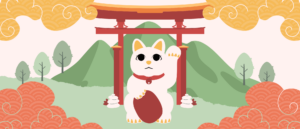The Story of the Waving Cat: The Meaning and History Behind the Maneki-Neko in Chinese Culture

If you’ve ever stepped into a Chinese restaurant, shop, or business, you’ve probably noticed a small, cheerful cat figurine sitting by the entrance, raising one paw in a waving or beckoning motion. I have always been curious about what they represent, and as cats are a huge part of our lives and as local cat sitters in Blackheath, here is what I found out….
This is the Maneki-Neko (招き猫), also known as the “beckoning cat,” and while it’s often thought to be Japanese in origin, its presence in Chinese culture is just as significant.
Though the Maneki-Neko’s roots are in Japan, its symbolism representing luck, wealth, and prosperity has made it a beloved figure in Chinese businesses and households, where it’s believed to invite good fortune and protect against misfortune.
But what exactly does this cat mean? Why is it waving its paw? And how did it become a symbol of prosperity across different cultures?
Let’s explore the fascinating history of the Maneki-Neko, its symbolism in Chinese tradition, and the different meanings behind this iconic feline figurine.
The Origins of the Maneki-Neko: A Tale of Good Fortune
The Maneki-Neko is widely believed to have originated in Japan during the Edo period (1603–1868). While there are many legends about how the Maneki-Neko came to be, the most famous story is that of a poor temple monk and a stray cat.
The Legend of the Temple Cat
According to legend, a humble monk lived in a small, struggling temple in Tokyo. Despite having very little, the monk shared what little food he had with a stray cat that frequently visited the temple.
One day, during a storm, a wealthy samurai passed by the temple. He noticed the cat sitting near the entrance, raising its paw as if beckoning him inside.
Curious, the samurai followed the cat into the temple just before a bolt of lightning struck the spot where he had been standing. Grateful to the cat for saving his life, the samurai became the temple’s patron, bringing prosperity and growth to the once-struggling establishment.
This tale of a cat bringing good fortune and saving lives gave birth to the Maneki-Neko, which became a symbol of protection and prosperity.
How the Maneki-Neko Found Its Way to Chinese Culture
Although the Maneki-Neko originated in Japan, its symbolism and popularity quickly spread to neighboring cultures, including China. The cat’s reputation as a bringer of luck and prosperity resonated deeply with Chinese values around wealth, protection, and positive energy.
In Chinese culture, symbols of good fortune are deeply rooted in tradition. Concepts such as Feng Shui emphasize the placement of objects to enhance positive energy, and the idea of using a figurine like the Maneki-Neko to invite prosperity naturally aligned with these beliefs.
By the 20th century, the Maneki-Neko had become a common sight in Chinese-owned businesses, where it was embraced as a symbol of wealth, good luck, and protection from harm.
Why Does the Cat Wave? Understanding the Gesture
One of the most recognizable features of the Maneki-Neko is its raised paw, which looks like a wave. But this motion isn’t actually a wave — it’s a beckoning gesture.
In Japanese and Chinese cultures, the motion of drawing the hand or paw toward oneself is a gesture used to invite or beckon someone to come closer. So, while Western observers might interpret it as a wave, the Maneki-Neko is actually inviting good fortune and prosperity.
Left Paw or Right Paw? The Different Meanings
Interestingly, the position of the paw can change the meaning behind the Maneki-Neko, and understanding these subtle differences helps explain why some cats raise one paw while others raise both.
1. Left Paw Raised: Inviting Customers and People
A Maneki-Neko with its left paw raised is believed to attract customers and people. This version is commonly placed in restaurants, shops, and businesses to draw in more foot traffic.
2. Right Paw Raised: Inviting Wealth and Prosperity
When the right paw is raised, the Maneki-Neko is said to invite wealth and financial prosperity. This version is often seen in homes and offices, where the focus is on attracting money and good fortune.
3. Both Paws Raised: Maximum Protection and Luck
Occasionally, you’ll find a Maneki-Neko with both paws raised, offering a combination of protection and prosperity. This version is believed to safeguard against misfortune while simultaneously inviting good fortune.
Symbolism of Colors: What Does the Color of the Cat Mean?
In addition to the position of the paw, the color of the Maneki-Neko also carries symbolic meaning.
Gold: Represents wealth and prosperity. The most common color for Maneki-Neko in Chinese businesses.
White: Symbolizes purity, happiness, and positive energy.
Black: Offers protection from evil spirits and negativity.
Red: Brings good health and wards off illness.
Green: Associated with safety and harmony, often used in homes for balance.
Pink: Symbolizes love and romance, though less commonly seen.
Chinese Folklore and the Cat as a Symbol of Prosperity
While the Maneki-Neko has Japanese origins, the concept of cats as symbols of good fortune and protection aligns perfectly with Chinese beliefs.
Cats as Guardians Against Evil Spirits
In ancient China, cats were valued for their ability to protect grain stores by keeping rodents away. Because of this, cats became associated with protection and security. Over time, this practical role transformed into a spiritual one, where cats were believed to guard households against negative energies and evil spirits.
Feng Shui and the Maneki-Neko
In Chinese Feng Shui, placement plays a key role in influencing the flow of positive energy, or chi. The Maneki-Neko is often placed near the entrance of a home or business to invite good fortune inside.
For optimal results:
Place the Maneki-Neko near the front door to welcome prosperity.
If placed in a business setting, position the cat facing the entrance to draw in customers.
For financial prosperity, it’s best to position the Maneki-Neko in the wealth corner of a home or office, typically the southeast corner according to Feng Shui principles.
Variations of the Maneki-Neko: Understanding the Accessories
Maneki-Neko figurines often come with a variety of accessories that add to their symbolic meaning:
Coin (Koban): A coin inscribed with the phrase “10 million ryo,” representing immense wealth and prosperity.
Bib and Bell: Represents protection and honor, often symbolizing devotion and respect to deities.
Fish or Mallet: Signifies abundance and good fortune.
Modern-Day Popularity of the Maneki-Neko in Chinese Businesses
Today, the Maneki-Neko is a staple in Chinese-owned businesses around the world. Whether displayed in restaurants, shops, or homes, its presence is a testament to the enduring belief that a little feline charm can invite good fortune and prosperity.
In Chinese communities, the Maneki-Neko has become a symbol that transcends borders, blending the ancient values of luck and protection with a modern flair. Even though its origins lie in Japan, its symbolism has been fully embraced in Chinese culture, where the concept of inviting prosperity and guarding against harm resonates deeply.
Why the Maneki-Neko Continues to Charm Us
The Maneki-Neko isn’t just a cute decoration, it’s a symbol rich with history, culture, and meaning. Whether it’s waving to welcome customers into a shop or beckoning good fortune into a home, this little cat continues to hold a special place in the hearts of those who believe in its power.
In a world where we often search for symbols of hope and prosperity, the Maneki-Neko stands as a reminder that sometimes, a simple gesture , even from a small figurine can carry deep significance.
So, the next time you see a Maneki-Neko waving its paw at you from the corner of a restaurant or a shop, take a moment to appreciate the centuries of tradition, protection, and good fortune that this humble cat brings into our lives.
